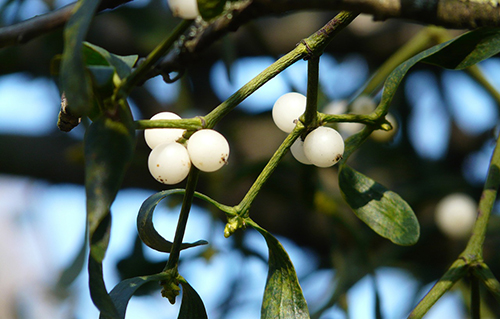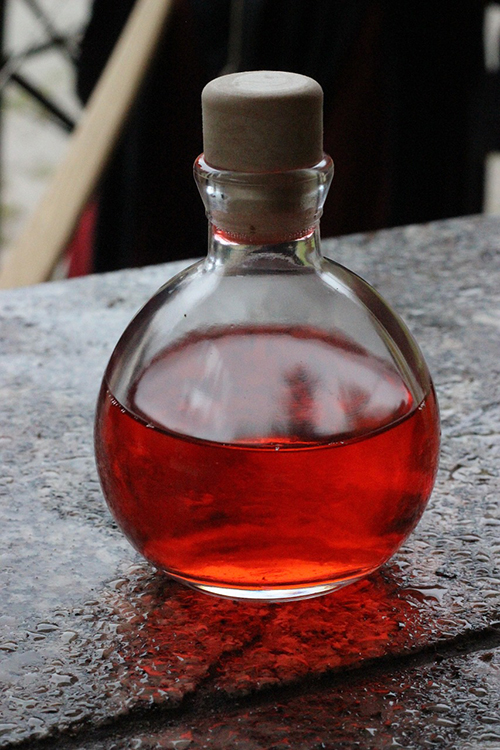Mistletoe is a strange plant. Neither tree nor shrub, it grows between soil and sky on the branches of other trees. It’s parasitic in nature.
According to Philip and Stephanie Carr-Gomm, mistletoe bears very sticky berries that birds like the mistle thrush and the blackcap enjoy. The mistle thrush “deposits” the seeds after eating them. The blackcap wipes their beaks on tree bark to get rid of the goo. This leaves behind the seeds so they can take hold on a new host. Mistletoe commonly grows on “apple, sycamore, ash, lime, poplar, field maple and hawthorn” (2018: 78).

Incidentally, the plant’s scientific name is viscum album, which literally translates as ‘white goo’. Which I think is just marvellous.
So how did a parasitic, poisonous plant come to be linked with Christmas? Hit play to hear the podcast episode or keep reading to find out!
Mistletoe and the Druids
Mistletoe represents fertility. After all, as an evergreen plant, it stands out against the bare branches of dormant trees in winter. The druids believed the pearly pulp of the berries was the semen of the Oak King.
The Carr-Gomms describe the druid ceremony of Alban Arthan at the Winter Solstice. All lights are extinguished to represent the longest night. A single candle is lit and everyone lights their candle from it to represent the returning sun. The mistle berries symbolise this particular moment so mistletoe is distributed to all (2018: 78).
Pliny claimed the druids harvested mistletoe with a golden sickle. They caught it in a cloak because it lost its magic powers if it touched the ground. It’s entirely possible this is utter gut rot, based on Pliny’s tendency towards the outlandish.
But 18th-century antiquarian William Stukeley brought the idea into the public imagination during his campaign to revive interest in druidic traditions.

It’s rarely found on the oak and ancient Druids viewed mistletoe as sacred if it was. Felling an oak that played host to the parasitic plant invited disaster.
In fact, Margaret Baker recounts the story of the Hay family in Perthshire. An oak on their land played host to mistletoe, and the family prospered for generations. Local legends explained that the oak protected the family from witchcraft. It also stopped faeries from replacing the children with changelings. But all good luck runs out and eventually the estate passed out of the family. Locals noted the oak tree had been felled shortly before (2011: 100).
Fertility Links
Baker suggests that kissing under the mistletoe was actually a fertility rite (2011: 101). In some countries, the sprigs had to be burned by Twelfth Night. Otherwise, those who kissed under it would never marry.
Mistletoe was so potent that in Italy, women carried sprigs of it to aid conception.
Trevor Dines relates an old fertility rite involving mistletoe and hawthorn (2015). Farmers made bunches from the two plants and set fire to them. Then they went to the first-sown field and carried the burning bundle over the first twelve ridges. It ensured the fertility of the crops in the coming year. Bad luck would follow if the fire went out before the farmer finished the rite.
The plant also pops up in Greek legend, after Aeneas plucks ‘the golden bough’. Having done so, he can journey to the land of the dead to speak to his dead father, Anchises. According to mistletoe.org.uk, many scholars think the golden bough refers to mistletoe since European mistletoe looks gold during the winter
Did the kissing link come from Norse mythology?
In Norse mythology, Frigg made all living things swear an oath never to harm Baldr, god of light. Frigg only extracted the oath from anything on or under the earth. But Loki realised she’d missed the mistletoe – because it technically grows above the earth.
So Loki made a dart from its wood and tricked Baldr’s blind brother, Höd, into throwing it. The dart killed Baldr.
According to Margaret Baker, Robert Graves actually made his own mistletoe dart to see if such a feat were possible. It was (2011: 99).
In one version of the story, Frigg cried over the dart lodged in her dead son. The tears turned into the white berries, and Frigg used them to bring Baldr back to life. In return to the miracle, she promised anyone a kiss who passed under the mistletoe.
A number of versions of this story end very differently. In many of them, Baldr ends up in Niflheim, the kingdom of the dead. So it’s difficult to tell if the kissing tradition begins with this story.
But when did mistletoe end up as a Christmas decoration?
Some believe that kissing under the mistletoe started in the festival of Saturnalia. In Scandinavia, the plant represented peace. If you wanted to declare a truce, you kissed under the mistletoe. And what better time to declare a truce than at Christmas?
In the medieval era, families hung mistletoe in the house during December to ward off evil. It was then burnt after Christmas – presumably to get rid of any evil it had collected during the month.
But it really starts making an appearance in the home in the 18th and 19th centuries in Britain. Even Charles Dickens described scenes of festive kissing in The Pickwick Papers (1836).

Some believe you’re supposed to remove a berry for every kiss. The good luck for kissing runs out when the berries do.
In Victorian England, if a girl refused to grant a kiss under the mistletoe, she wouldn’t receive any marriage proposals at all the following year.
The White Goddess website note that church decorations excluded mistletoe, a ban which continues today. They theorise its unpopularity with the church comes from its connection with the druids.
The folklore of the plant
Mistletoe appears within folklore in a pretty wide range of guises. It doesn’t just open all locks. It also protects the home from fire and lightning during festivals held on the Solstices.
In the Ozarks, farmers hung the plant in their smokehouses to keep witches from stealing the meat. The local folk also used both the leaves and the berries in top-secret love potions.

(NB: The leaves can be used in medicine as a sedative nerve tonic and anti-convulsant. But the berries are HIGHLY toxic so please do not ingest this plant)
Evan Andrews notes that ancient societies used mistletoe to heal “everything from menstrual cramps to spleen disorders” (2018).
In folk medicine, the plant went by the name ‘Allheal’. People believe it defeated poisons, protected against witchcraft, and cured illness (The White Goddess).
Folk in Normandy used it to get rid of fleas in their bedding. Hung above a cradle, the plant would stop faeries stealing a baby.
There’s also a tradition that mistletoe was the wood of the cross. In Brittany, people believed that the plant was punished. The small tree became a parasitic plant in retaliation for its part in the crucifixion.
But whatever its origin, this strange little plant has become intrinsically linked with Christmas! It even made an appearance in Batman Returns (1992), during Batman and Catwoman’s flirtation.
So do keep your eye out for any mistletoe this year – but always ask permission before you try to land a kiss!
Enjoy this post? Why not become a patron for exclusive content?
References
Andrews, Evan (2018), ‘Why do we kiss under the mistletoe?’, History.com, https://www.history.com/news/why-do-we-kiss-under-the-mistletoe. Accessed 6 December 2019.
Baker, Margaret (2011) Discovering the Folklore of Plants, 3rd edition, Oxford: Shire Classics.
Carr-Gomm, Philip and Stephanie (2018), The Druid Plant Oracle, London: Eddison Books.
Dines, Trevor (2015), ‘Why we kiss under mistletoe’, BBC, http://www.bbc.co.uk/earth/story/20151215-why-we-kiss-under-mistletoe. Accessed 6 December 2019.
The White Goddess (no date), ‘Mistletoe’, The White Goddess, http://www.thewhitegoddess.co.uk/articles/mythology_folklore/mistletoe.asp. Accessed 6 December 2019.
Nutty about folklore and want more?
Add your email below and get these posts in your inbox every week.
You'll also get my 5-step guide to protecting your home using folklore!








Love how all plants have a use, I get boggled by it and also in awe of plants AND how people find it out too – experimentation I guess. Loved the stories behind mistletoe didn’t actually know any of them! So I’ve learnt something new. My fave bit is that for each berry lost, it’s one kiss. That’s cute.
Yeah I was fascinated to look into it! I’m amazed at how many people use mistletoe for medicine.